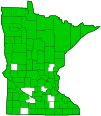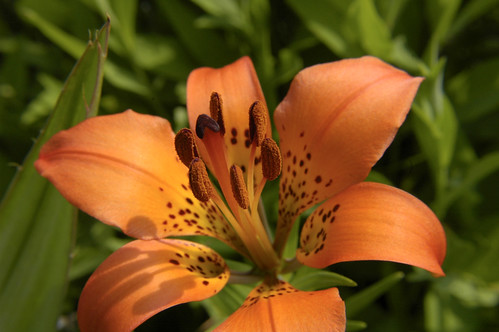wood lily
(Lilium philadelphicum var. andinum)
Conservation • Wetland • Description • Habitat • Ecology • Use • Distribution • Taxonomy
Description |
||
Wood lily is a 12″ to 36″ tall, erect, hairless, unbranched perennial rising from a chunky bulb. The leaves are scattered, more or less alternate, except the uppermost, which are in a whorl. They are stalkless, 2″ to 4″ long, lance-shaped, and taper to a sharp point. The tips droop when the sky is overcast, and ascend in the sun. The inflorescence is a terminal cluster of flowers arising from a single point at the top of the stem. There may be 1 to 5 flowers, but there are rarely more than 3. The large flowers are 2½″ wide and are not fragrant. They are widely bell shaped and erect—they do not hang downward. They consist of 6 distinctly clawed tepals, 3 inner tepals (petals) that are similar in appearance but somewhat wider and shorter than the 3 outer tepals (sepals). The tepals are spoon-shaped and narrow to a slender, stalk-like base (claw). They are erect and flaring, and bend backward slightly toward their tips. They do not touch near the base. They are bright orange or reddish-orange with a yellow throat and purple spots near the throat. The tips come to a blunt point. The stamens equal or project beyond the tepals. |
||
Height |
||
12″ to 36″ |
||
Flower Color |
||
Bright orange or reddish-orange |
||
Similar Species |
||
Michigan lily (Lilium michiganense) is much taller, 3′ to 6′ at maturity. The leaves are whorled except near the top, where they are single, in pairs, or in partial whorls. The flowers are 2½″ to 3″ wide, Turk’s-cap shaped, with tepals that bend backward to their base. Orange daylily (Hemerocallis fulva) is taller, 2′ to 4′ at maturity. It has a basal rosette of grass-like leaves and no leaves on the flowering stem. The flowers are up to 4″ wide, semi-erect or horizontal, funnel-shaped, tannish-orange with a yellow throat and a red stripe. They do not have spots near the throat. They last only one day. Tiger lily (Lilium lancifolium) has a central stalk that is densely covered with long, tangled, white hairs, especially near the top. The leaves are alternate, even at the top of the stem. The inflorescence is a terminal, branched, elongated, cluster of 3 to 6 flowers, not an umbel. The flowers hang downward at the end of stout, widely spreading flower stems. They are Turk’s-cap shaped, up to 4″ wide and uniformly orange to reddish-orange—they do not have yellow or yellowish throats. They have purple-brown spots except near the tips, not just near the throat. They last more than one day. |
||
Habitat |
||
Dry. Tall-grass and mid-grass prairies. Full sun to partial sun. |
||
Ecology |
||
Flowering |
||
June to August |
||
Pests and Diseases |
||
|
||
Use |
||
|
||
Distribution |
||||
|
Sources |
|||
| 7/1/2022 | ||||
Nativity |
||||
Native |
||||
Occurrence |
||||
Widespread but not common. Wood lily is becoming increasingly rare due to habitat loss and grazing by whitetail deer. |
||||
Taxonomy |
|||
| Kingdom | Plantae (Plants) | ||
| Division | Tracheophyta (Vascular Plants) | ||
| Subdivision | Spermatophytina (Seed Plants) | ||
| Class | Liliopsida (Monocots) | ||
Order |
Liliales (lilies, supplejacks, and allies) | ||
Family |
Liliaceae (lilies) | ||
| Subfamily | Lilioideae | ||
| Tribe | Lilieae | ||
Genus |
Lilium (true lilies) | ||
| Species | Lilium philadelphicum (wood lily) | ||
Synonyms |
|||
Lilium andinum Lilium montanum Lilium philadelphicum var. montanum Lilium umbellatum |
|||
Common Names |
|||
American Turk’s-cap lily lily-royal swamp lily Turk’s-cap Turk’s-cap Lily western orange-cup lily western wood lily wood lily |
|||
Glossary
Claw
A stalk-like narrowed base of some petals and sepals.
Sepal
An outer floral leaf, usually green but sometimes colored, at the base of a flower.
Tepal
Refers to both the petals and the sepals of a flower when they are similar in appearance and difficult to tell apart. Tepals are common in lilies and tulips.
Umbel
A flat-topped or convex umbrella-shaped cluster of flowers or buds arising from more or less a single point.
Visitor Photos |
|||||
Share your photo of this plant. |
|||||
| This button not working for you? Simply email us at info@MinnesotaSeasons.com. Attach one or more photos and, if you like, a caption. |
|||||
Greg Watson |
|||||
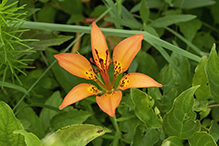 |
|||||
Dan W. Andree |
|||||
Wood Lily etc. growing in previous Spring 2021... Prescribed burn area at Frenchman’s Bluff 6-26-21. Up on top the big hill. There were several of them. Regrowth is coming along nicely. I am not sure what date the prescribed burn took place but it was sometime in the Spring of 2021 since there was a few black burned spots between some grasses and plants in some areas. I hadn’t been out there until recently (late June 2021) this season. |
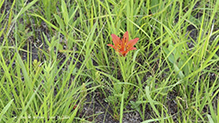 |
||||
"Wood Lily"... Out in rural Norman Co. Mn. after a light isolated rain shower. |
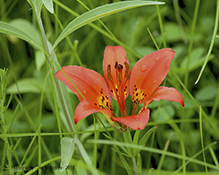 |
||||
Bill Reynolds |
|||||
| The Wood lily is fairly common up here, living in many of the roadway ditches. I have quite a few growing on my property. | 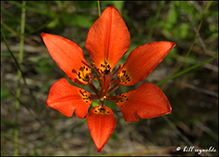 |
||||
MinnesotaSeasons.com Photos |
|||||
Plant |
|||||
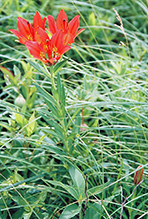 |
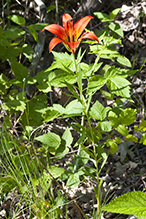 |
||||
Inflorescence |
|||||
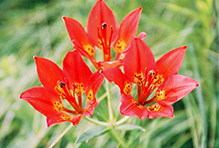 |
|||||
Flower |
|||||
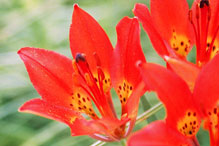 |
|||||

Visitor Videos |
|||
Share your video of this plant. |
|||
| This button not working for you? Simply email us at info@MinnesotaSeasons.com. Attach a video, a YouTube link, or a cloud storage link. |
|||
Other Videos |
|||
| Wood Lily (Lilium philadelphicum) Wandering Sole TV |
|||
About
Published on Jul 3, 2013 A Wood Lily growing by the Kicking Horse River in Yoho National Park. The Wood Lily also goes by the names of Philadelphia Lily, Prairie Lily, Western Red Lily, or Mountain Lily. It is native to North America and can be found in many parts of Canada and the United States. The plant is threatend, endangered, or extirpated in many parts of the continent because of people picking the flower. The picking of the plant results in non-renewal for the bulb the next season. A variant of the species, the Western Red Lily (L. philadelphicum andinum) is the provincial flower of Saskatchewan. |
|||
| Northern Crescents and Lilium philadelphicum. Whitesand Lake, Saskatchewan, 29 June 2013 Victoriabirder |
|||
About
Published on Oct 10, 2013 No description available. |
|||
| Rediscovering Lilium philadelphicum (Wood Lily) in Grundy County, MO chemysterious |
|||
About
Uploaded on Jun 8, 2010 MONPS members find over 70 Eastern Prairie Fringed Orchids and a Wood Lily on a prairie in northern Missouri on a weekend when flooding made navigation tricky. |
|||

Visitor Sightings |
|||||
Report a sighting of this plant. |
|||||
| This button not working for you? Simply email us at info@MinnesotaSeasons.com. Be sure to include a location. |
|||||
| Greg Watson 6/28/2022 |
Location: King’s and Queen’s Bluff SNA |
 |
|||
| Dan W. Andree 7/2/2018 |
Location: Frenchman’s Bluff SNA Prescribed burn area at Frenchman’s Bluff 6-26-21. Up on top the big hill. There were several of them. Regrowth is coming along nicely. I am not sure what date the prescribed burn took place but it was sometime in the Spring of 2021 since there was a few black burned spots between some grasses and plants in some areas. I hadn’t been out there until recently (late June 2021) this season. |
||||
| Dan W. Andree 7/2/2018 |
Location: Sandpiper Prairie SNA Out in rural Norman Co. Mn. after a light isolated rain shower. |
||||
| Bill Reynolds 7/19/2008 |
Location: Pennington County MN The Wood lily is fairly common up here, living in many of the roadway ditches. I have quite a few growing on my property. |
||||
MinnesotaSeasons.com Sightings |
|||||

|
Created: Last Updated: © MinnesotaSeasons.com. All rights reserved. |
